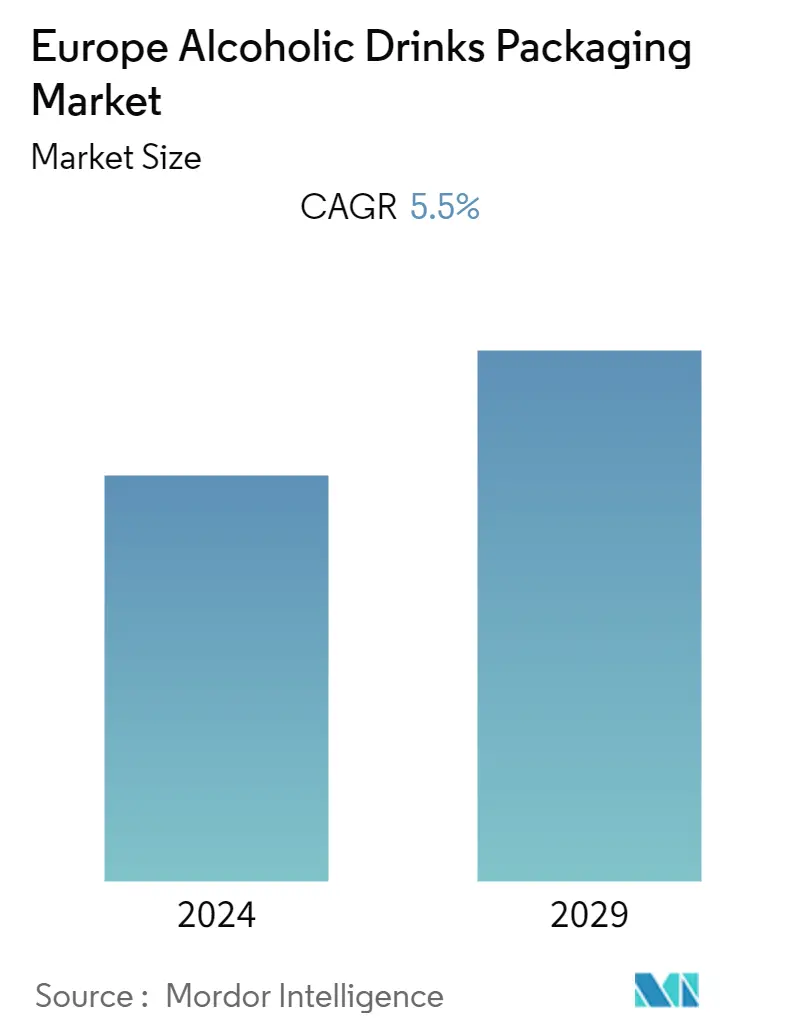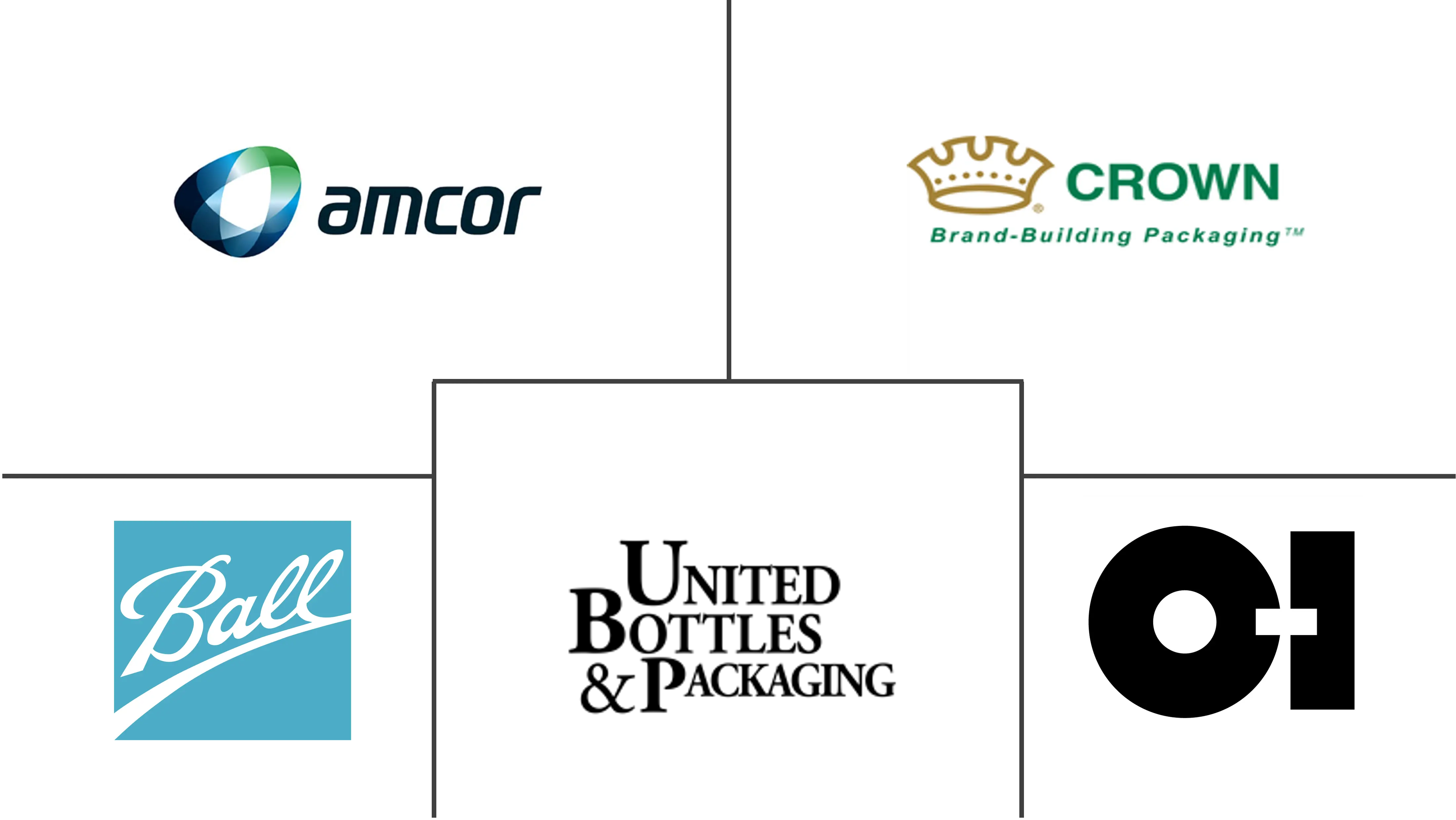Market Size of Europe Alcoholic Drinks Packaging Industry

| Study Period | 2019 - 2029 |
| Base Year For Estimation | 2023 |
| Forecast Data Period | 2024 - 2029 |
| Historical Data Period | 2019 - 2022 |
| CAGR | 5.50 % |
| Market Concentration | Medium |
Major Players
*Disclaimer: Major Players sorted in no particular order |
Europe Alcoholic Drinks Packaging Market Analysis
The Europe alcoholic drinks packaging market is expected to record a CAGR of 5.5% during the forecast period. The packaging of alcoholic beverages plays a significant role in the brand promotion of alcoholic drinks. It helps brands to communicate with their consumers as they can touch and feel the product through packaging. Recent innovation such as lightweight glass and effective recycling is driving the market.
- The demand for alcoholic drinks is anticipated to rise in the United Kingdom, Italy, Germany, and Finland, which will help the packaging industry in Europe expand. Manufacturers of alcoholic beverage packaging in Europe benefit from the rising trend of alcohol use during social gatherings since it opens up new business prospects. In Europe, young consumers are becoming more accustomed to drinking beer and wine.
- Glass is a popular choice for packaging since it does not react with the chemicals in drinks and, as a result, protects the scent, strength, and flavor of these beverages. Packaging materials like glass are anticipated to be in high demand. As a result, glass bottles are used for packaging the majority of beer sales. Throughout the forecast, this tendency is anticipated to persist. Since glass packaging is entirely recyclable, it is a desirable packaging choice for sustainability.
- The increased acceptability of cans among young customers led to significant demand for aluminum can packaging from canned wine and beer producers. This tendency has been progressively pushed by a substantial cultural shift since millennials are enthusiastic consumers of various wine forms that provide convenience.
- Craft positioning is becoming more significant across alcoholic beverages as customers choose to drink less but better, pushing firms to use packaging to communicate their message. This may be seen in the increase in beverage packaging, such as metal beverage cans for beer and glass bottles with cork closures for alcohol.
- The COVID-19 epidemic did not affect total alcohol consumption; beer and wine sales increased while hard liquor sales decreased. Budget and mid-range spirits increased in demand, while high-end super-premium and ultra-premium spirits saw a decline in demand. There have been significant increases in the demand for wholesale wine and beer as people cut back on socializing and spend more time at home. Consumers are paying more for each bottle than before the epidemic.
Europe Alcoholic Drinks Packaging Industry Segmentation
Alcoholic beverage packaging plays a prominent role in brand promotion, increasing brand visibility. At present, alcoholic beverage manufacturers are ardent about providing top packaging standards for their products to influence consumers to purchase their brand. The report offers a brief understanding of the packaging products used for alcoholic beverages packaging in the United States. The various packaging products considered for the study are - bottles, metal cans, cartons, and pouches. These products use various packaging materials, such as plastic, paper, metal, and glass.
The European Alcoholic Drinks Packaging Market is segmented by Material (Plastic, Paper, Metal, Glass), Alcoholic Products (Beer, Spirits, Wine, Ready-to-drink), Product Type (Plastic Bottles, Glass Bottles, Metal Cans, Cartons, Pouches), and Country.
The market sizes and forecasts are provided in terms of value (USD million) for all the above segments.
| By Primary Material | |
| Plastic | |
| Paper | |
| Metal | |
| Glass |
| By Alcoholic Products | |
| Wine | |
| Spirits | |
| Beer | |
| Ready-to-drink (RTD) | |
| Other Types of Alcoholic Beverages |
| By Product Type | |
| Plastic Bottles | |
| Glass Bottles | |
| Metal Cans | |
| Cartons | |
| Pouches | |
| Other Product Types |
| By Country | |
| United Kingdom | |
| France | |
| Italy | |
| Germany | |
| Rest of Europe |
Europe Alcoholic Drinks Packaging Market Size Summary
The European alcoholic drinks packaging market is poised for significant growth, driven by the increasing demand for innovative and sustainable packaging solutions. The market is experiencing a shift towards environmentally friendly materials, such as glass and aluminum, which are favored for their recyclability and ability to preserve the quality of beverages. The trend of premiumization and the rising popularity of craft beverages are encouraging manufacturers to invest in packaging that not only protects but also enhances brand appeal. The adoption of lightweight glass and the growing acceptance of aluminum cans, particularly among younger consumers, are notable trends that are shaping the market landscape. Additionally, the COVID-19 pandemic has influenced consumer behavior, leading to a rise in home consumption and a preference for convenient packaging options like Bag-in-Box, which offers sustainability and practicality.
The competitive landscape of the European alcoholic drinks packaging market is characterized by the presence of numerous players offering diverse packaging solutions, which intensifies market competition. Companies are increasingly focusing on flexible packaging formats to cater to the preferences of millennials, who value portability and convenience. The market is also witnessing a surge in alcohol gifting, prompting brands to innovate in packaging design to attract consumers. Regulatory changes and consumer awareness regarding the environmental impact of packaging materials are driving the demand for sustainable alternatives. Partnerships and acquisitions among key players, such as Amcor and Berlin Packaging, are further enhancing the market's capacity to meet the evolving demands of the European market.
Europe Alcoholic Drinks Packaging Market Size - Table of Contents
-
1. MARKET DYNAMICS
-
1.1 Market Overview
-
1.2 Industry Value Chain Analysis
-
1.3 Industry Attractiveness - Porter's Five Forces Analysis
-
1.3.1 Threat of New Entrants
-
1.3.2 Bargaining Power of Buyers
-
1.3.3 Bargaining Power of Suppliers
-
1.3.4 Threat of Substitute Products
-
1.3.5 Intensity of Competitive Rivalry
-
-
1.4 Market Drivers
-
1.4.1 High Purchasing Power of Consumers
-
1.4.2 Increasing Consumption of Alcoholic Drinks
-
-
1.5 Market Challenges
-
1.5.1 Increasing Environmental and Sustainability Concerns
-
-
1.6 Assessment of the Impact of COVID-19 on the Market
-
-
2. MARKET SEGMENTATION
-
2.1 By Primary Material
-
2.1.1 Plastic
-
2.1.2 Paper
-
2.1.3 Metal
-
2.1.4 Glass
-
-
2.2 By Alcoholic Products
-
2.2.1 Wine
-
2.2.2 Spirits
-
2.2.3 Beer
-
2.2.4 Ready-to-drink (RTD)
-
2.2.5 Other Types of Alcoholic Beverages
-
-
2.3 By Product Type
-
2.3.1 Plastic Bottles
-
2.3.2 Glass Bottles
-
2.3.3 Metal Cans
-
2.3.4 Cartons
-
2.3.5 Pouches
-
2.3.6 Other Product Types
-
-
2.4 By Country
-
2.4.1 United Kingdom
-
2.4.2 France
-
2.4.3 Italy
-
2.4.4 Germany
-
2.4.5 Rest of Europe
-
-
Europe Alcoholic Drinks Packaging Market Size FAQs
What is the current Europe Alcoholic Drinks Packaging Market size?
The Europe Alcoholic Drinks Packaging Market is projected to register a CAGR of 5.5% during the forecast period (2024-2029)
Who are the key players in Europe Alcoholic Drinks Packaging Market?
Amcor plc, Owens-Illinois Inc., United Bottles & Packaging, Crown Holdings Inc. and Ball Corporation are the major companies operating in the Europe Alcoholic Drinks Packaging Market.

